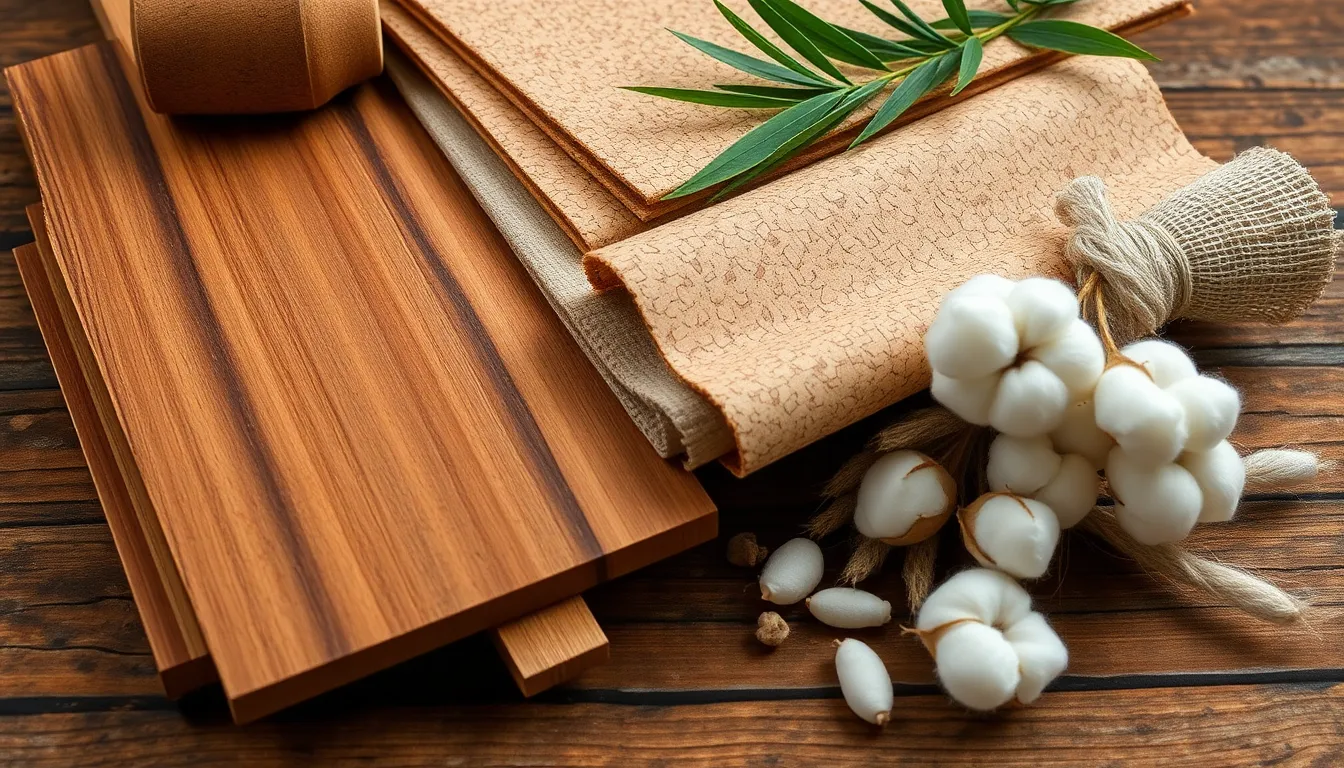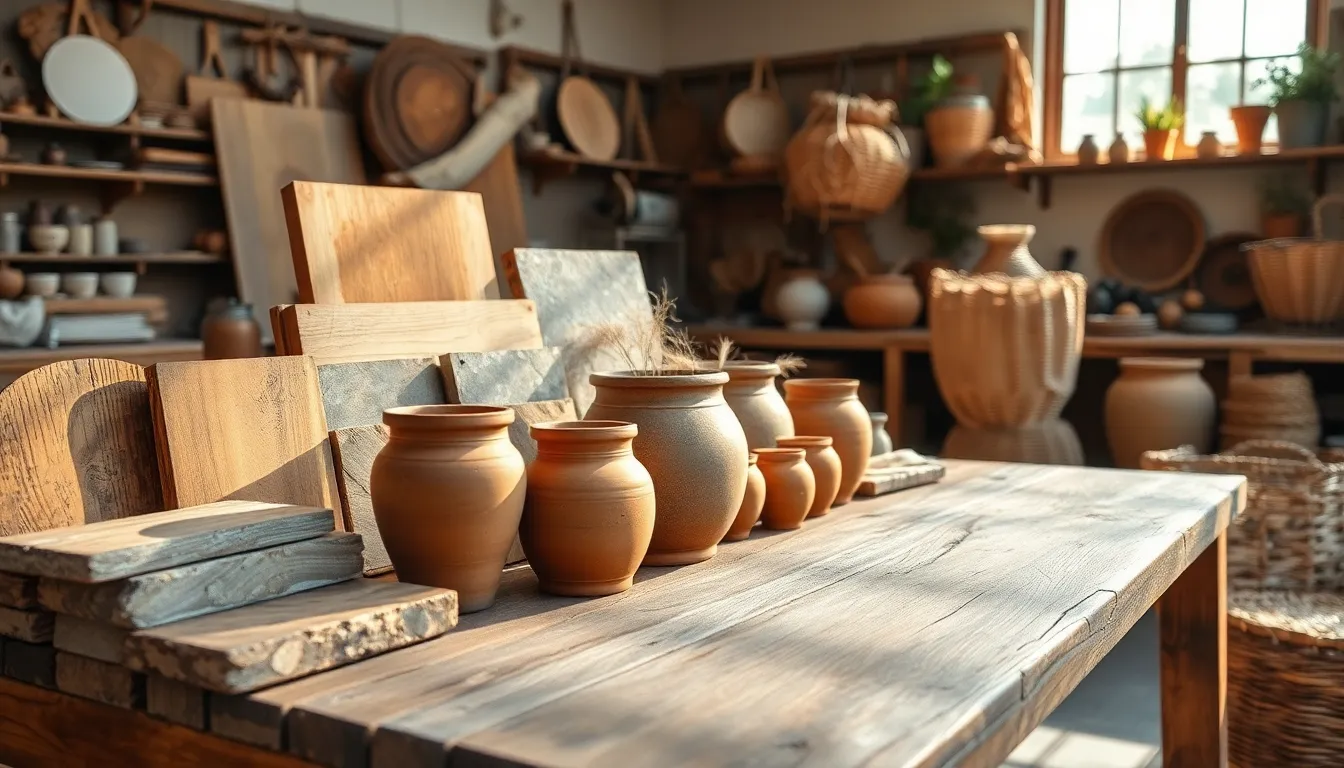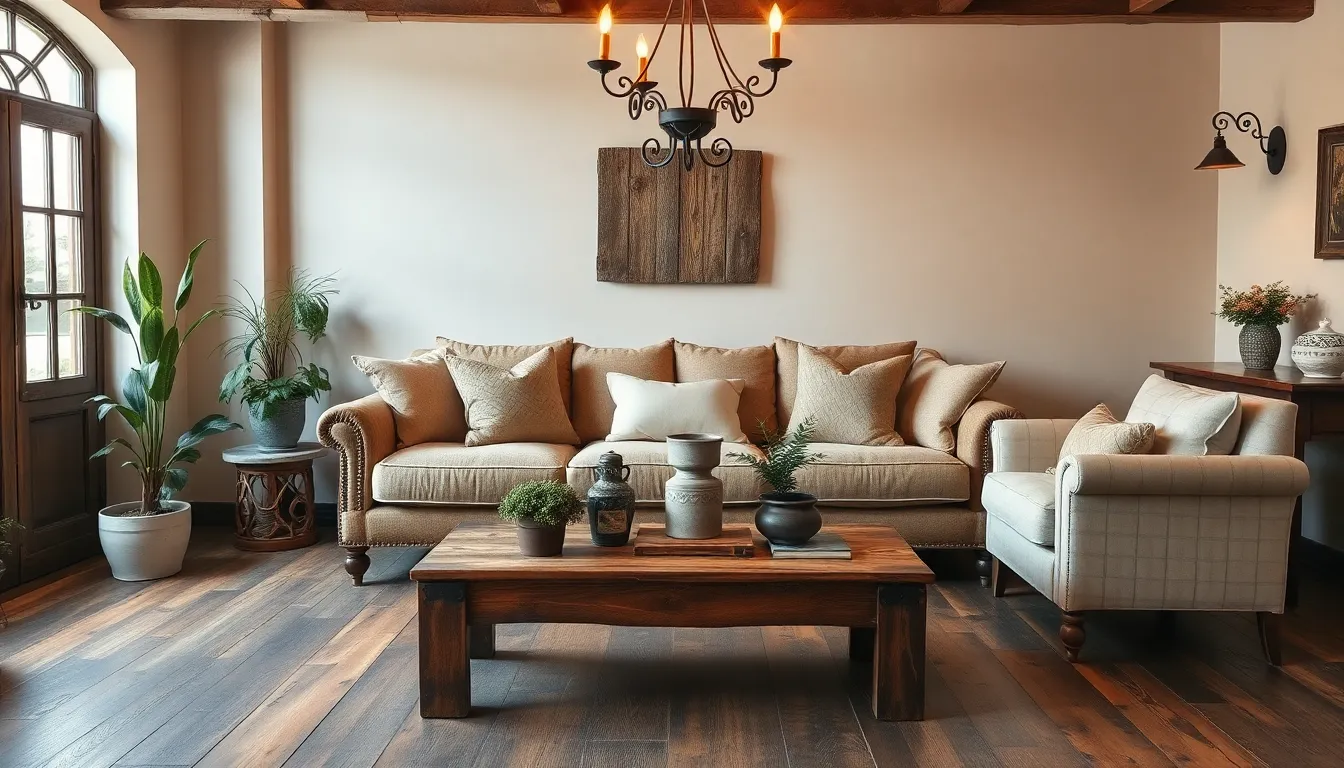In a world increasingly dominated by synthetic options, natural materials are making a powerful comeback. These materials, sourced from the earth, not only offer unique aesthetic qualities but also promote sustainability and environmental responsibility. From the warmth of wood to the elegance of stone, natural materials bring a timeless charm to architecture, design, and fashion.
As consumers grow more conscious of their choices, the demand for eco-friendly products rises. Natural materials provide an attractive alternative that blends beauty with functionality. They’re not just a trend; they represent a shift towards a more sustainable lifestyle. By embracing these materials, individuals can connect with nature while enhancing their living spaces, making every choice count towards a healthier planet.
Table of Contents
ToggleOverview of Natural Materials
Natural materials encompass a wide range of organic substances sourced from the Earth. Key examples include wood, stone, clay, and natural fibers. Each material boasts distinctive properties that cater to various applications across multiple industries.
Natural materials exhibit several advantages, such as sustainability, durability, and aesthetic appeal. Wood, for instance, offers strength and versatility in construction and furniture design. Stone provides a timeless quality, often utilized in architecture and landscaping. Clay serves as a fundamental resource in pottery and ceramics, while natural fibers like cotton, linen, and jute enhance textiles and fashion.
The appeal of natural materials lies in their ability to create unique atmospheres. Visual characteristics like texture, color, and grain patterns contribute to bespoke designs, allowing artisans to craft distinctive products. Additionally, natural materials often require less energy to produce, reducing their carbon footprint.
As environmental awareness grows, the demand for responsibly sourced natural materials increases. Certifications, such as FSC for wood and organic standards for textiles, ensure sustainable harvesting practices. Consumers are more inclined to choose products made from these materials, recognizing their impact on the environment.
Incorporating natural materials into daily life promotes a connection to nature. Spaces filled with organic elements can enhance well-being, offering a calming and inviting atmosphere. The shift towards natural materials not only supports individuality in design but also aligns with the global movement towards sustainability and eco-friendliness.
Types of Natural Materials

Natural materials fall into three main categories: plant-based, mineral-based, and animal-based. Each category offers unique properties, applications, and benefits that support sustainability and aesthetic appeal.
Plant-Based Materials
Plant-based materials derive from living plants and include wood, bamboo, cork, and natural fibers such as cotton, linen, and jute.
- Wood: Widely used in construction and furniture, wood provides durability, strength, and versatility. It can be sustainably sourced, minimizing environmental impact.
- Bamboo: Fast-growing and renewable, bamboo serves as an eco-friendly alternative to traditional timber. Its lightweight and strong characteristics make it ideal for various applications.
- Cork: Harvested from cork oak trees, cork exhibits excellent insulation properties and is biodegradable. Its unique texture adds warmth and charm to interiors.
- Natural Fibers: Cotton, linen, and jute enhance textiles with breathable, comfortable attributes. These fibers are biodegradable and contribute to reducing synthetic material usage.
Mineral-Based Materials
Mineral-based materials come from naturally occurring minerals and rocks. This category includes stone, clay, and sand.
- Stone: Marble, granite, and slate offer timeless quality and are often employed in architecture and landscaping. Their longevity and low maintenance make them a preferred choice.
- Clay: Used to create ceramics and pottery, clay provides versatility in design and functionality. It can be shaped and fired into durable items, such as tableware and tiles.
- Sand: Fundamental in construction, sand combines with cement and aggregates to form concrete. Its availability and strength make it essential for modern building practices.
Animal-Based Materials
Animal-based materials originate from animal products and include leather, wool, and silk.
- Leather: Known for its durability and aesthetic appeal, leather is widely used in fashion and upholstery. Sustainable leather options now exist, promoting ethical sourcing and production methods.
- Wool: Sourced from sheep, wool offers insulation and moisture-wicking properties. It is commonly used in clothing and textiles, benefiting from natural resilience against pests and fire.
- Silk: Produced by silkworms, silk exudes luxury and elegance. It is lightweight and breathable, making it an ideal choice for high-quality garments and home furnishings.
Benefits of Using Natural Materials
Natural materials provide several benefits that promote sustainability and well-being. Their use positively impacts the environment and health, offering distinct advantages over synthetic alternatives.
Environmental Impact
Natural materials significantly reduce environmental harm through their sustainable sourcing and lower energy requirements during production. Wood absorbs carbon dioxide, acting as a carbon sink, while plant-based materials can renew more efficiently than synthetic options. The natural biodegradability of materials like cotton and wool minimizes landfill waste, promoting a circular economy. Mineral-based materials, such as stone and clay, require minimal processing, conserving energy and resources. Certification systems, such as the Forest Stewardship Council (FSC), ensure responsible sourcing practices, further enhancing the ecological benefits associated with natural materials.
Health Considerations
Selecting natural materials contributes to healthier living environments. Many synthetic materials contain harmful chemicals, releasing volatile organic compounds (VOCs) into indoor air. Natural fibers, like linen and hemp, provide hypoallergenic properties, reducing exposure to allergens. Wood and stone materials improve indoor air quality as they do not emit harmful substances. Additionally, using natural materials can enhance overall well-being, fostering a connection to nature, which studies suggest may reduce stress and improve mood. Thus, integrating natural materials into homes and workplaces promotes physical and mental health.
Applications of Natural Materials
Natural materials have diverse applications across multiple industries. Their unique properties offer advantages that align with sustainable practices and aesthetic preferences.
Construction and Building
Natural materials like wood, stone, and clay play vital roles in construction and building. Wood provides structural integrity, durability, and insulation, making it a preferred choice for residential and commercial applications. Stone, known for its sturdiness and longevity, enhances building aesthetics, often used in facades and landscaping. Clay, utilized in bricks and tiles, offers thermal regulation and moisture management. These materials reduce energy consumption during production and contribute to healthier indoor environments through their low emissions.
Textiles and Fashion
Natural fibers such as cotton, linen, wool, and silk dominate the textiles and fashion industry. Cotton and linen, recognized for their breathability and comfort, appeal to consumers seeking quality clothing. Wool, appreciated for its insulation and moisture-wicking properties, remains a staple in colder climates. Silk adds luxury and elegance to garments. The use of sustainable practices in sourcing these materials supports ethical fashion and reduces environmental impact, aligning production with eco-conscious consumer values.
Art and Craft
Artists and crafters increasingly embrace natural materials for their unique textures and aesthetics. Wood, clay, and natural fibers serve as foundational materials in various art forms. Wood facilitates the creation of intricate carvings and sculptures, while clay offers versatility for pottery and ceramics. Natural fibers, like cotton and jute, enhance textile arts through weaving and crafting. By utilizing these materials, artists foster a connection to nature, promoting sustainability and individuality in their creations.
Natural materials are more than just a trend; they represent a significant shift towards sustainability and well-being. By embracing these materials, individuals can create spaces that reflect their values and foster a connection to nature. The unique qualities of plant-based, mineral-based, and animal-based materials not only enhance aesthetic appeal but also contribute to healthier living environments.
As the demand for eco-friendly options continues to rise, choosing natural materials becomes a powerful statement about one’s commitment to the planet. This choice promotes responsible sourcing and supports the broader movement towards sustainable practices. Ultimately, incorporating natural materials into daily life enriches both personal spaces and the environment, paving the way for a healthier future.




